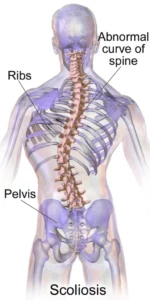
Scoliosis is a common condition of the spine that chiropractors encounter regularly. Scoliosis refers to changes in the curvature of the spine so that it bends sideways, usually “S” or “C”- shaped. This can happen to varying degrees, some are very obvious causing a lot of postural distortion, and others can be very mild, only noticeable on close inspection or in certain positions like bending. Scoliosis can be thoroughly assessed with chiropractic methods and in most cases help to manage the pain & other symptoms that may develop. You can read more about our approach to posture here.
Why and how does scoliosis develop?
Despite its prevalence, the cause of scoliosis is unknown. Most lateral curvatures in the spine develop around the onset of puberty and between the ages of 12-20. It is thought a combination of genetic and environmental factors can predispose someone to developing scoliosis. Indeed if you have a scoliosis, it is likely you have a family member who also suffers from it. Scoliosis is thought to affect around 3% of the population, with females to males affected 4:1.
Is scoliosis painful or a risk factor in developing back problems?
Depending on the severity, general health and fitness of the individual, and the stresses affecting that person, having a scoliosis can lead to back pain and other issues related to the postural distortion. The common presentations are:
-Pain in the lower back or mid back
-Pain in the ribcage or flank
-Pain in the neck
-Shoulder pain and/or mobility issues in the shoulders
-Severe cases can cause symptoms in the lungs, heart and stomach
What are the signs of scoliosis
Most scoliosis can be visually seen when assessing the posture and spine from behind or side on. Sometimes with scoliosis the spine can appear straight when the person in standing erect, but when they bend forward the curvature in the spine becomes apparent and there is a characteristic ‘rib hump’ on one side. Typical signs include:
-One shoulder higher than the other
-One side of the pelvis higher than the other
-Uneven musculature on one side of the spinal column
-Uneven leg length or rarely arm length
-Torsion of the ribcage causing a prominent area of the ribs to protrude
-A more prominent shoulderblade on one side due to the ribcage torsion
Assessment of Scoliosis
If a scoliosis is suspected, usually x-rays will be taken to see how the spine is distorting. Sometimes a lateral curvature also affects the normal curves in the spine called the lumbar lordosis and thoracic kyphosis. X-rays can also help rule out any sinister underlying causes.
If the person has not yet reached skeletal maturity (around 25), the scoliosis will need to be monitored regularly to make sure it is not getting worse or progressing in severity.
Management of Scoliosis
Depending on the nature and severity of scoliosis, different approaches can be taken to help the patient. In severe progressive cases, a brace is worn (like a strong corset) to help keep the spine straight. In the most extreme cases of scoliosis, surgery is done to place metal rods on either side of the spine to keep it erect and straight.
In the vast majority of cases, the symptoms and signs of scoliosis can be managed conservatively, using exercise, physical therapy and approaches like chiropractic.
Chiropractic management of scoliosis
A chiropractor will approach each case of scoliosis with a thorough assessment to ascertain the extent of the curvature, the way the posture is distorting, and how this is affecting the musculature. Treatment includes adjusting the joints of the spine and pelvis to free up tension and restriction in the joint movement. Chiropractic can help relieve the muscle tension and help the body adapt better to the compensations, particularly the shoulder and pelvic girdle imbalances. It is important to note that most cases of scoliosis are structural so can’t be cured, but careful management and treatment can provide significant relief.
Conclusion
The vast majority of people with scoliosis live perfectly normal lives and manage their condition well. In those cases of postural distortion whereby the body isn’t so able to adapt, chiropractic can help by releasing joint restriction and tension. We often find the top and bottom area’s where the curvature begins and ends are frequently restricted and not moving well. By adjusting these areas, the body is freer and more capable of functioning well. A chiropractor may also recommend certain stretches and exercises, or lifestyle changes to help your spine function better.
background info & image adapted from: Wikipedia contributors. (2022, August 31). Scoliosis. In Wikipedia, The Free Encyclopedia. Retrieved 14:32, September 2, 2022, from https://en.wikipedia.org/w/index.php?title=Scoliosis&oldid=1107784313
